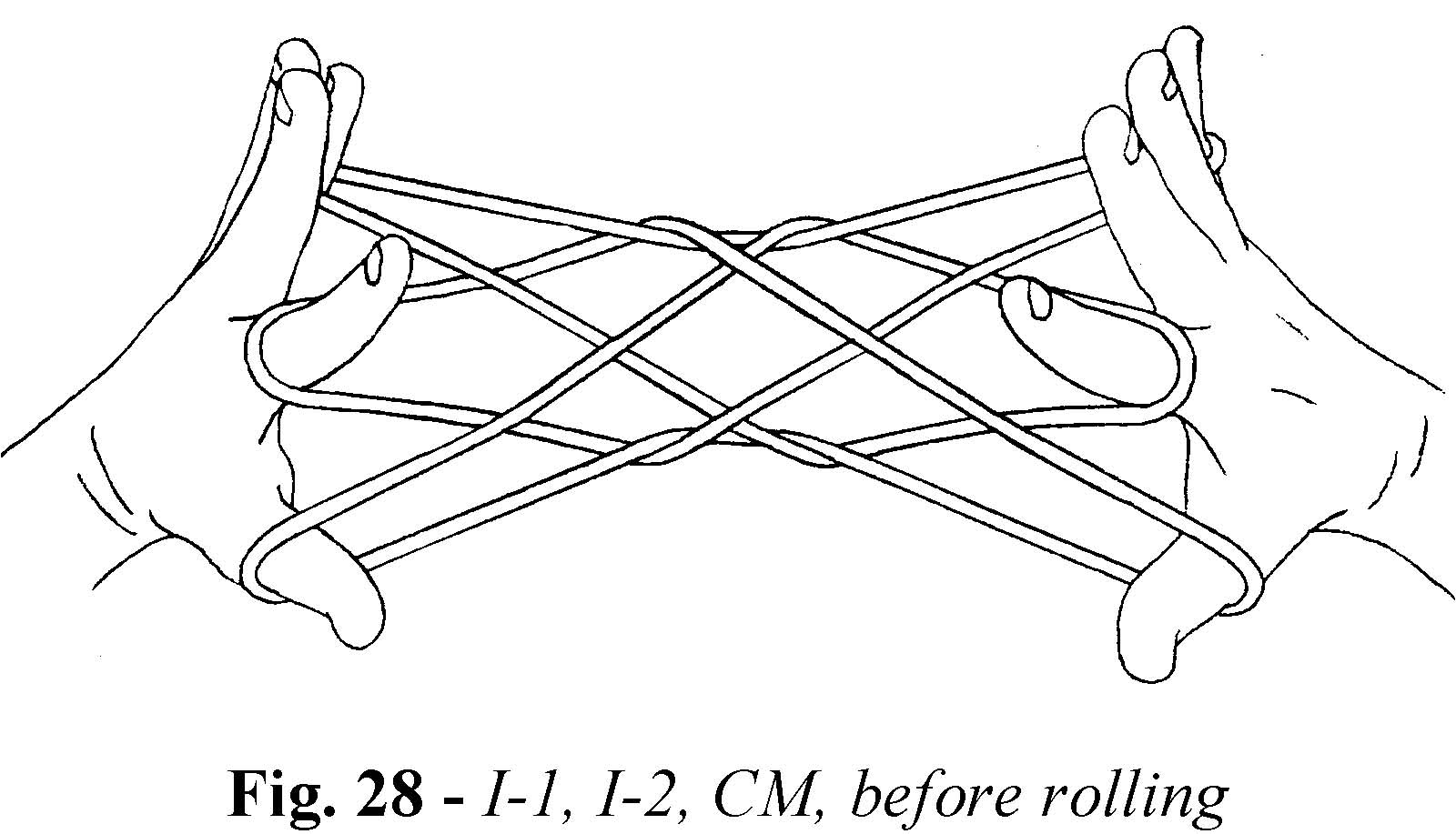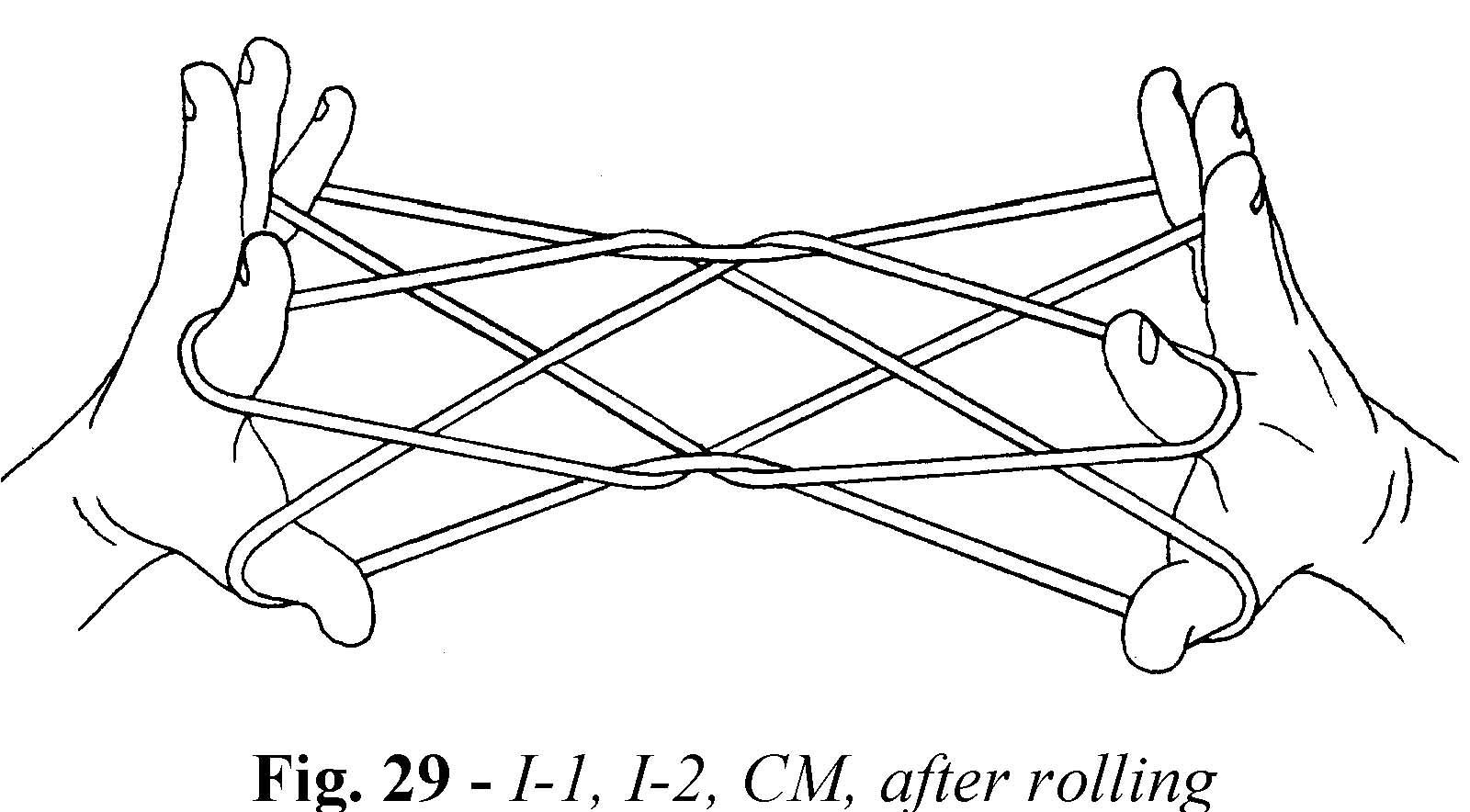rolling the figure
Rolling is a technique for “turning over” a loom or a partially completed figure so that the underside can be manipulated. A crude way to “turn over” Opening A would be to lay the figure on your lap, fingers pointing down, release all loops, then reinsert the fingers from below (i.e., insert the thumb into the former little finger loop, the index into the former index loop — but from the opposite side — and the little finger into the former thumb loop). This achieves a +1/2 rotation of the entire figure (assuming that the axis of rotation is a line connecting the knuckle of each index finger). A much more elegant way of doing this is as follows:
- Transfer the thumb loop to the middle finger, inserting the middle finger from above (this introduces a +1/2 spin).
- Pass each thumb away from you under all the strings, pick up the far little finger string and return with it, then drop the little finger loop (this is merely a way of transferring the little finger loop to the thumb while simultaneously introducing a +1/2 spin).
- Transfer the middle finger loop to the little finger, inserting the little finger from below.
- Transfer the index loop to the thumb, inserting the thumb from below, then retransfer this loop to the index, inserting the index from above (this introduces a +1/2 spin). The entire figure has now been rotated a half turn away from you.
Weaving the Inuit Net from a rolled version of Opening A is not very exciting — two string crossings in the center of the final pattern will differ. But when applied to a partially woven version of the Inuit Net (one that resembles Opening A), the effect is quite dramatic. For practice try the following: Do Opening A, the First and Second Inuit Weaves, and the Continuation Move (you now have something that resembles Opening A, fig. 28); next, roll the entire figure as described above so
that the underside is now facing upward (fig. 29), then make the Inuit Net from the beginning, as if you had Opening A on your hands. The result is shown in fig. 30. Rolling is an important technique to master — i use it extensively in some of my higher order creations such as the Inuit bridge.
THE ITERATION MOVE (IM)
The Iteration Move is hybrid move — a cross between the Continuation Move and Rolling. Like rolling, it inverts a partially completed figure so that the underside can be manipulated. But unlike rolling, the partially completed figure need not resemble Opening A. In fact, it is best applied just after completing the first weave of a North American Net: Iteration Move (performed just after I-1, N-1, or K-1 or their primes)
- Pass each thumb away from you under all the strings, pick up the far little finger string, and return; drop the little finger loop (this transfers the little finger loop to the thumb and introduces a +1/2 spin).
- Transfer the middle finger loop (or upper index loop if you started with K-1) to the thumb (over the index loop), inserting the thumb from below, then retransfer this loop to the little finger, inserting the little finger from above (this move shifts the middle finger loop to the little finger while simultaneously introducing a +1/2 spin).
- Transfer the index loop to the thumb, inserting the thumb from below, then retransfer this loop to the index, inserting the index from above (this introduces a +1/2 spin). The entire figure has now been rotated a half turn away from you.
As an exercise try the following: Do Opening A, followed by the first weave of the Klamath Net (K-1), and apply the Iteration Move. Now make the Klamath Net from the beginning, as if you had Opening A on your hands. The result is shown in fig. 31.
The Iteration move is used extensively in a figure i call "cherokee seven stars".

things to consider
note that you should be becoming more adept at considering new ways of using the methods you are now practicing. later lessons will add many more to your repertoire.



